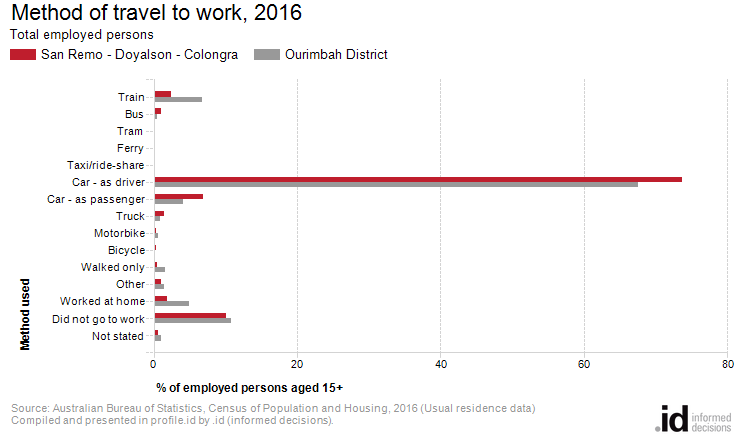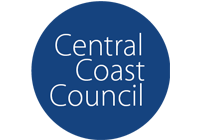San Remo - Doyalson - Colongra
Method of travel to work
On Census day 2016 in San Remo - Doyalson - Colongra, 80.6% of people travelled to work in a private car, 3.3% took public transport and 0.8% rode a bike or walked. 1.8% worked at home.
San Remo - Doyalson - Colongra's commuting statistics reveal the main modes of transport by which residents get to work. There are a number of reasons why people use different modes of transport to get to work including the availability of affordable and effective public transport options, the number of motor vehicles available within a household, and the distance travelled to work.
Commuting data is very useful in transport planning as it informs decision-makers about the availability, effectiveness and utilisation of local transport options, particularly when analysed with Residents Place of Work data and Car Ownership.
WARNING: Method of travel to work relates to Census day, which for the 2021 Census occurred during COVID-19 lockdowns for large parts of Australia. In lockdown, many occupations were required to work from home if possible, and some industries were closed, so people did not go to work. For this reason, these categories may have increased, with corresponding declines in other methods of travel. Use the data with caution when comparing over time. For more details, please refer to the data notes.
Derived from the Census question:
'How did the person get to work on Tuesday, 10 August 2021?'
Employed persons aged 15 years and over
Source: Australian Bureau of Statistics, Census of Population and Housing (opens a new window) 2006 and 2016. Compiled and presented by .id (opens a new window)(informed decisions).
(Usual residence data)

Compiled and presented in profile.id by .id (informed decisions).

Compiled and presented in profile.id by .id (informed decisions).
Dominant groups
In 2016, there were 62 people who caught public transport to work (train, bus, tram or ferry) in San Remo - Doyalson - Colongra, compared with 1,528 who drove in private vehicles (car – as driver, car – as passenger, motorbike, or truck).
Analysis of the method of travel to work of the residents in San Remo - Doyalson - Colongra in 2016, compared to Ourimbah District, shows that 3.3% used public transport, while 80.6% used a private vehicle, compared with 7.2% and 71.6% respectively in Ourimbah District.
The major differences in persons between the method of travel to work of San Remo - Doyalson - Colongra and Ourimbah District were:
- A larger percentage of persons who travelled by car (as driver) (73.7% compared to 67.5%)
- A larger percentage of persons who travelled by car (as a passenger) (6.9% compared to 4.1%)
- A smaller percentage of persons who travelled by train (2.4% compared to 6.7%)
- A smaller percentage of persons who worked at home (1.8% compared to 5.0%)
Emerging groups
The number of employed people in San Remo - Doyalson - Colongra increased by 217 between 2006 and 2016.
The largest change in the method of travel to work by resident population in San Remo - Doyalson - Colongra between 2006 and 2016 was for those nominated:
- Car - as driver (+294 persons)
